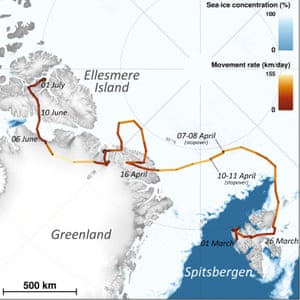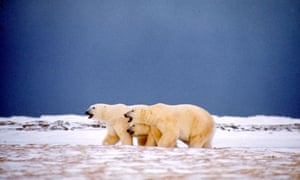
Fantastic arctic fox: animal walks 3,500km from Norway to Canada
Epic journey by female fox includes fastest movement rate for species ever recorded
Alison Rourke
Tue 2 Tue 2 Jul 2019
The arctic fox used sea ice to travel from Norway to Greenland to Canada. Photograph: Arterra/Universal Images Group via Getty Images
An arctic fox has walked more than 3,500km (2,000 miles) from Norway to Canada in just 76 days, astonishing researchers at the Norwegian Polar Institute.
The animal, known as a coastal or blue fox, was fitted with a tracking device in July 2017. It left Spitsbergen in Norway’s Svalbard archipelago on 26 March 2018. After 21 days and 1,512 km out on the sea ice, it landed in Greenland on 16 April 2018. Its journey continued to Ellesmere Island in Canada, where it arrived on 1 July.
“We first did not believe it was true,” said researcher Eva Fuglei, who tracked the female fox.
Fjellreven vandret via havisen fra #Svalbard i Europa til #Canada i Nord-Amerika i et tempo ingen forskere tidligere har dokumentert. Foto: Elise Stømseng Les mer: https://www.npolar.no/nyhet/fjellrev-krysset-arktis-pa-rekordtid …
The institute said in a research paper titled “One female’s long run across sea ice” that the Arctic fox’s journey was among the longest ever recorded. It was so long, in fact, that researchers initially questioned whether the fox’s collar could have been removed and taken on board a boat.
“But no, there are no boats that go so far up in the ice. So we just had to keep up with what the fox did,” Fuglei said.
The collar transmitted data each day for a three-hour period. Moving across sea ice and glaciers, the fox moved at an average of 46.3km per day and on one day travelled a whopping 155km, when it was on the ice sheet in northern Greenland,
The route of an arctic fox over 3,506km (2,178 miles), from Svalbard in Norway to Ellesmere Island in Canada. Photograph: Arnaud Tarroux / NINA
“This is, to our knowledge, the fastest movement rate ever recorded for this species,” Fuglei said in the paper.
Researchers believe the large amount of ground covered on that day could indicate the fox used the sea ice as a “means of transport”.
“The sea ice plays a key role in the fact that mountain foxes will migrate between areas, meet other populations and find food,” said Fuglei, adding that it was the first time they have documented in detail the migration of the species between continents and ecosystems in the Arctic.
The fox’s journey has raised concerns about how climate change’s affect on sea ice could impact animals’ ability to migrate.
The end of the Arctic as we know it
“This is another example of how important sea ice is to wildlife in the Arctic,” Norways climate and environment minister, Ola Elvestuen, told the Institute.“The warming in the north is frighteningly fast. We must cut emissions quickly to prevent the sea ice from disappearing all summer.”
The fox was tracked from an area where it would have survived on its GPS tracker stopped working in February this year.
Topics
“marine food resources”, including marine birds. Where it settled on Ellesmere island, it lived off predominantly lemmings, indicating its ability to switch ecosystems.
In winter, when food is scarce, Arctic foxes sometimes eat food left over by polar bears. Photograph: Co Rentmeester/The LIFE Picture Collection/Getty Images
Arctic foxes are incredibly hardy animals that can survive brutal freezing temperatures as low as 50C (-58F). The animals have furry-soled paws, short ears and a short muzzle to help them manage cold climates.
In winter food for the fox is scarce and they often follow larger predators, like polar bears, to eat their leftovers. They live on average for three to six years in the wild and weigh up to 7.5kg (17 lbs).
The ultimate fate of the fox is unknown – its GPS tracker stopped working in February this year.

Topics
Fantastic arctic fox: animal walks 3,500km from Norway to Canada






No comments:
Post a Comment